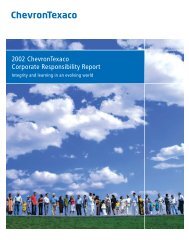Next* Magazine, Issue 5 - Chevron
Next* Magazine, Issue 5 - Chevron
Next* Magazine, Issue 5 - Chevron
You also want an ePaper? Increase the reach of your titles
YUMPU automatically turns print PDFs into web optimized ePapers that Google loves.
PHOTOS: TOP, STEVE MCCURRY; BOTTOM, PAUL S. HOWELL<br />
Ultimately, RDOC could help improve field development<br />
efficiency for projects requiring large numbers of similar<br />
wells, particularly for heavy oil and shale gas developments.<br />
Meanwhile, another solution called Waterflood Surveillance,<br />
Analysis and Optimization will focus on improving performance<br />
in <strong>Chevron</strong>’s global portfolio of 140 fields that use waterflooding.<br />
The fields produced more than 570,000 net barrels<br />
of oil per day in 2011.<br />
“Even though each oil field is different, all waterfloods<br />
have key operational elements and reservoir management<br />
activities that could be standardized globally,“ said waterflood<br />
specialist Ray Clark.<br />
The company’s digital oil field vision also includes<br />
complex asset management systems incorporating torrents<br />
of data and bundles of technologies. Real-Time Production<br />
Optimization/Reservoir Management, for example, uses<br />
real-time well and subsurface models based in geology and<br />
engineering to guide wells, facilities and operating system<br />
decisions.<br />
Beyond these initial global solutions, four more are in<br />
the works, including the Thermal Decision Support Center to<br />
optimize heavy oil production in Indonesia, the United States<br />
and the Middle East, where <strong>Chevron</strong> is a leader in steamstimulation<br />
technologies.<br />
But let’s back up a bit. What, exactly, is a digital oil field?<br />
Automation, Integration, Intelligence<br />
“The vision is real-time monitoring, analysis and control<br />
for optimum field management,” said Hauser. “We’ve seen<br />
a revolution in sensors to measure what’s happening down<br />
in the wells and in production equipment and have seen<br />
major advances in process instrumentation. And we’ve<br />
connected hardware and data to field performance models,<br />
continually analyzing information and making decisions to<br />
maximize output.”<br />
So it‘s about automation, but also integration—linking<br />
once-separate functions such as maintenance and drilling,<br />
and managing them within value chains. This requires<br />
streaming all relevant data into asset-decision environments,<br />
which fuse humans, data and technologies in a collaborative<br />
setting. Said <strong>Chevron</strong> i-field specialist Darrell Carriger,<br />
“Centralized surveillance allows management by exception,<br />
which enables a more efficient use of the workforce than<br />
manually checking every well and facility.”<br />
In addition to novel types of surveillance, new and<br />
innovative types of analysis programs search the clues<br />
to forecast when equipment will need service, repair or<br />
parts. More and better data, converted by software in real<br />
time into useful information, also enables another digital<br />
This geologic 3-D model is seen on the visualization screen at California‘s Kern<br />
River Field, an i-field digital oil field.<br />
In the Real-Time Drilling Optimization Center, drilling experts Carlos Hernandez<br />
(left) and Riley Houston study massive amounts of live trend data from wells the<br />
world over.<br />
<strong>Next*</strong> | 13

















